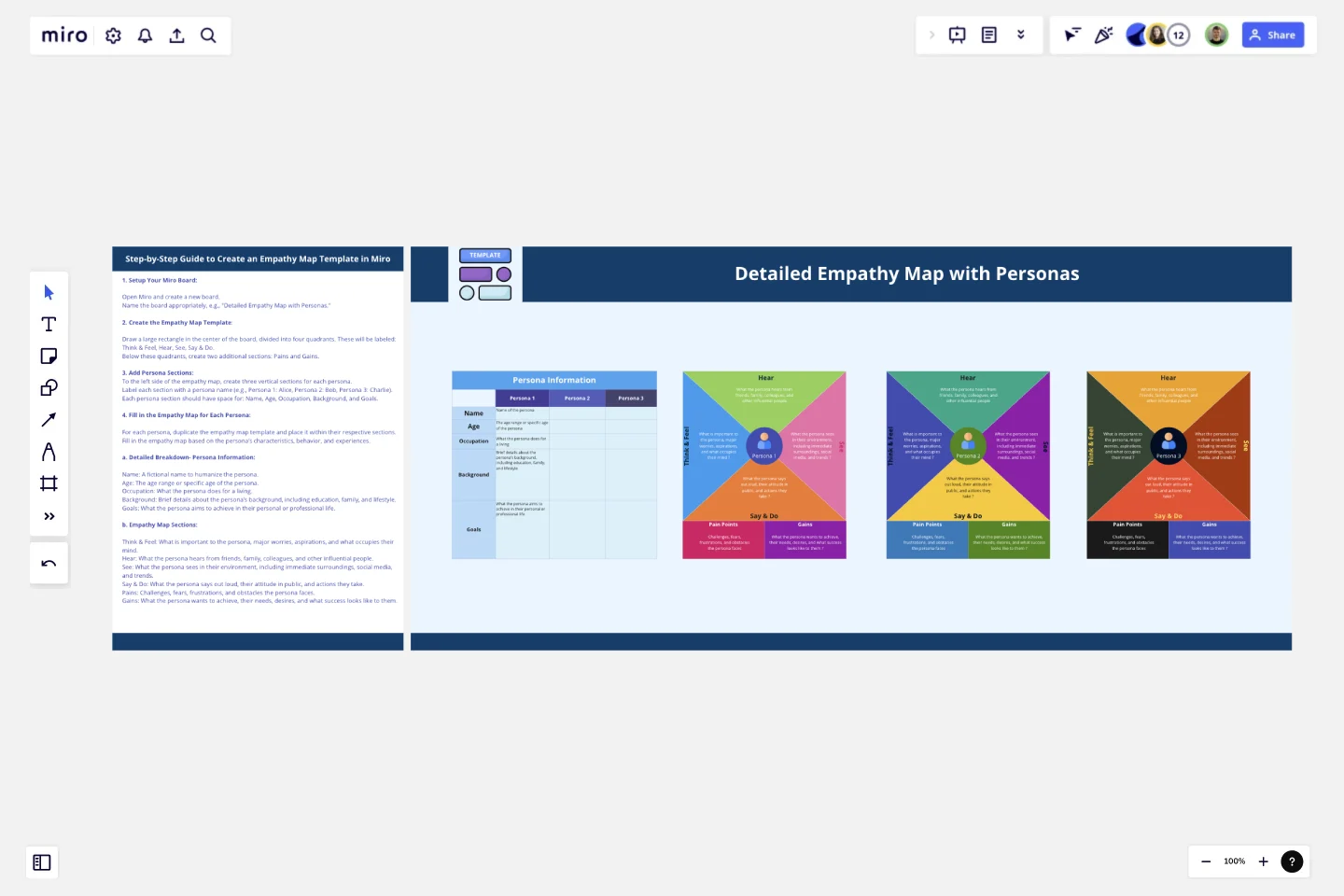Detailed Empathy Map With Personas
Importance and Uses of the Detailed Empathy Map with Personas Template
Importance
Deep Understanding of Users:
The empathy map helps in gaining a profound understanding of the users' needs, motivations, and experiences. It allows you to step into their shoes and see the world from their perspective.
Enhanced Product Development:
By understanding what users think, feel, see, hear, say, and do, you can create products and services that truly resonate with them. This ensures that the end product is user-centric and meets their expectations.
Improved Communication:
Empathy maps facilitate better communication within the team by providing a clear, visual representation of user personas. This helps align everyone's understanding and keeps the team focused on the user's needs.
Identifying Pain Points and Gains:
The template helps in identifying user pain points and what they want to achieve (gains). This information is crucial for addressing user challenges and enhancing their overall experience.
Informed Decision Making:
With detailed personas and empathy maps, decision-making becomes more informed and data-driven. It helps in prioritizing features, making design choices, and planning marketing strategies based on real user insights.
Increased User Engagement:
Understanding users on a deeper level allows you to create more engaging and relevant content, products, and services. This leads to increased user satisfaction and loyalty.
Uses
Product Development and Design:
Utilize the empathy map to guide product development teams in creating user-centric products. It ensures that the design and functionality align with user needs and preferences.
Marketing and Communication:
Use the personas and empathy maps to develop targeted marketing campaigns. Understanding the users’ thoughts, feelings, and behaviors helps in crafting messages that resonate with them.
Customer Journey Mapping:
Integrate empathy maps into customer journey mapping to visualize the entire user experience. This helps in identifying touchpoints, pain points, and opportunities for improvement.
User Research and Analysis:
Employ empathy maps as a tool for organizing and analyzing user research data. It helps in summarizing qualitative research findings and presenting them in a structured manner.
Stakeholder Alignment:
Share empathy maps with stakeholders to ensure everyone has a unified understanding of the target users. This fosters collaboration and consensus on user-centered goals and strategies.
Training and Onboarding:
Use the template to train new team members about the target audience. It provides a comprehensive overview of the users, helping newcomers quickly get up to speed with user-centric approaches.
Innovation and Ideation:
Leverage empathy maps during brainstorming sessions to generate innovative ideas that address real user needs. It provides a user-focused lens for creative problem-solving.
Service Design:
Apply the empathy map in service design to enhance user experiences across various touchpoints. It helps in designing services that are intuitive, efficient, and user-friendly.
By incorporating detailed empathy maps and personas into your processes, you can create more effective, user-centered solutions that drive engagement, satisfaction, and success.
This template was created by Khawaja Rizwan
Get started with this template right now.
Empathy Map for Customer Support
Works best for:
Empathy Map
Enhance your customer support with the Empathy Map for Customer Support template. This tool helps you understand your customers' emotions, challenges, and motivations. By mapping these insights, you can improve your support strategies, tailor responses, and provide a more empathetic service experience. Ideal for support teams looking to boost customer satisfaction and loyalty through deeper understanding and empathy.
User Flow Example
Works best for:
Flowcharts, Mapping, Diagrams
The User Flow Example template offers a visual representation of a typical user flow within a digital product or service. It provides elements for documenting user interactions, navigation paths, and decision points along the user journey. This template enables UX designers and product teams to understand user behavior, identify pain points, and optimize the user experience. By providing a concrete example of user flow, the User Flow Example template serves as a valuable reference for designing intuitive and engaging digital experiences that meet user needs effectively.
Flowchart Template
Works best for:
Flowcharts, Mapping, Diagrams
Trying to explain a process or workflow to your team — or just wrap your head around it yourself? Sometimes the best way is to see it, and that’s when you create a flowchart. Using common shapes (generally just ovals, rectangles, diamonds, and arrows), a flowchart shows you the direction a process or workflow goes and the order of steps. Beyond giving you a clear understanding, you’ll also be able to see potential flaws and bottlenecks, which helps you refine and improve your process and create a better product more efficiently.
UML Sequence Deployment Pipeline Template
Works best for:
UML
The UML Sequence Deployment Pipeline Template in Miro visually maps the sequence of steps in an automated deployment pipeline, helping teams in software development and deployment. It helps identify bottlenecks, standardizes the deployment process, and facilitates new member onboarding for continuous improvement.
Empathy Map for Product Development
Works best for:
Empathy Map
The Empathy Map for Product Development template helps you delve into the minds of your users, understanding their needs and pain points. Use this template to gather insights that inform your product features and design. By empathizing with your users, you can create products that truly resonate with them, leading to better adoption and satisfaction. Perfect for product managers and development teams.
Example Mapping Template
Works best for:
Product Management, Mapping, Diagrams
To update your product in valuable ways—to recognize problem areas, add features, and make needed improvements—you have to walk in your users’ shoes. Example mapping (or user story mapping) can give you that perspective by helping cross-functional teams identify how users behave in different situations. These user stories are ideal for helping organizations form a development plan for Sprint planning or define the minimum amount of features needed to be valuable to customers.
